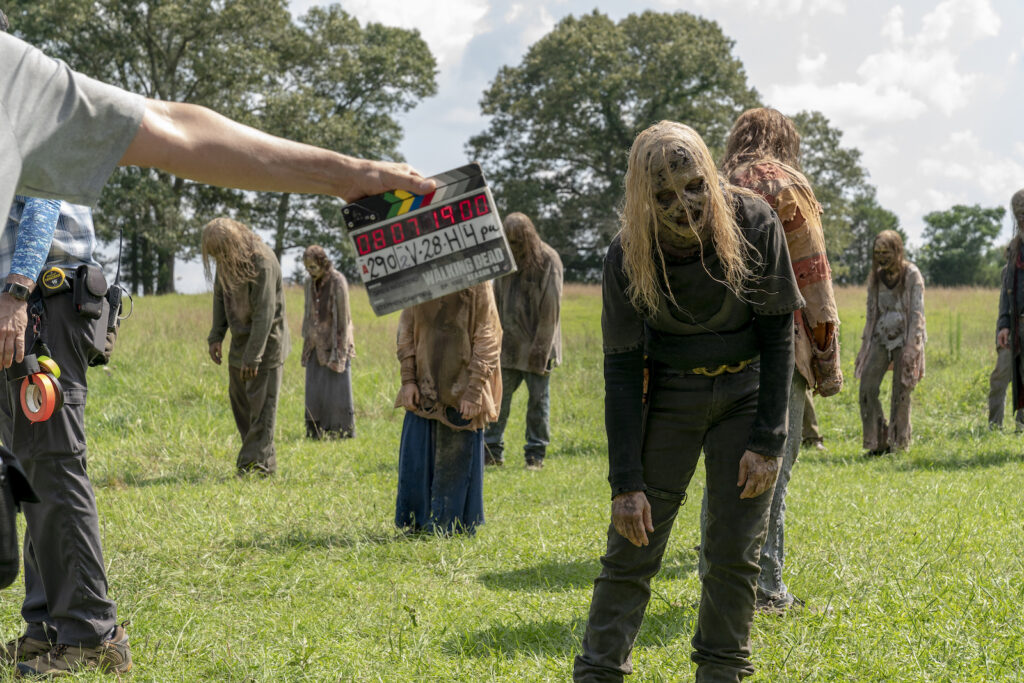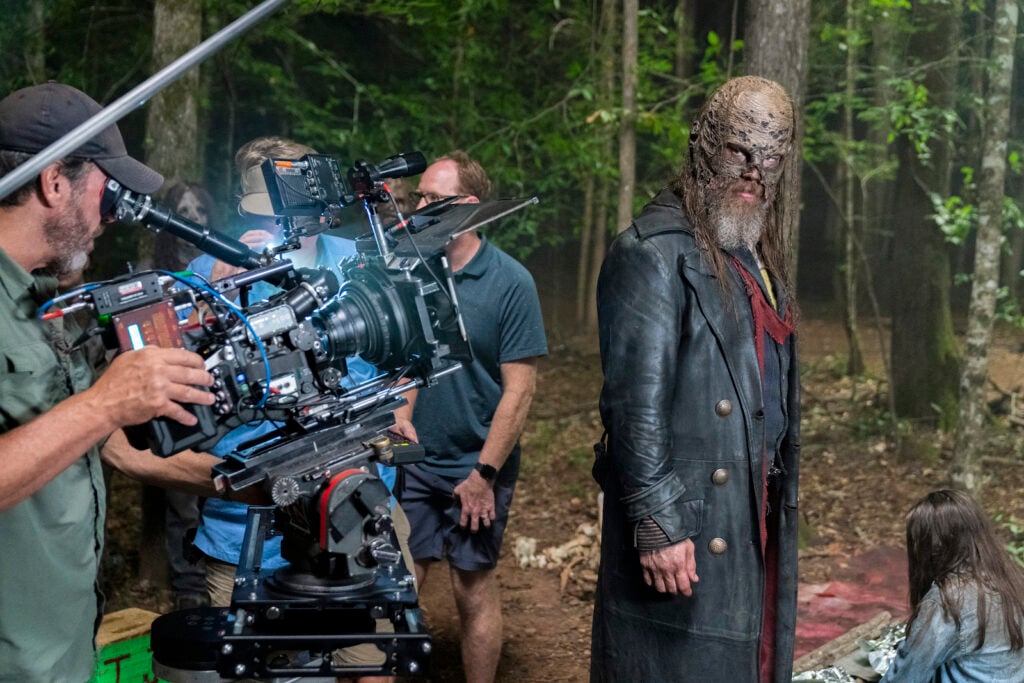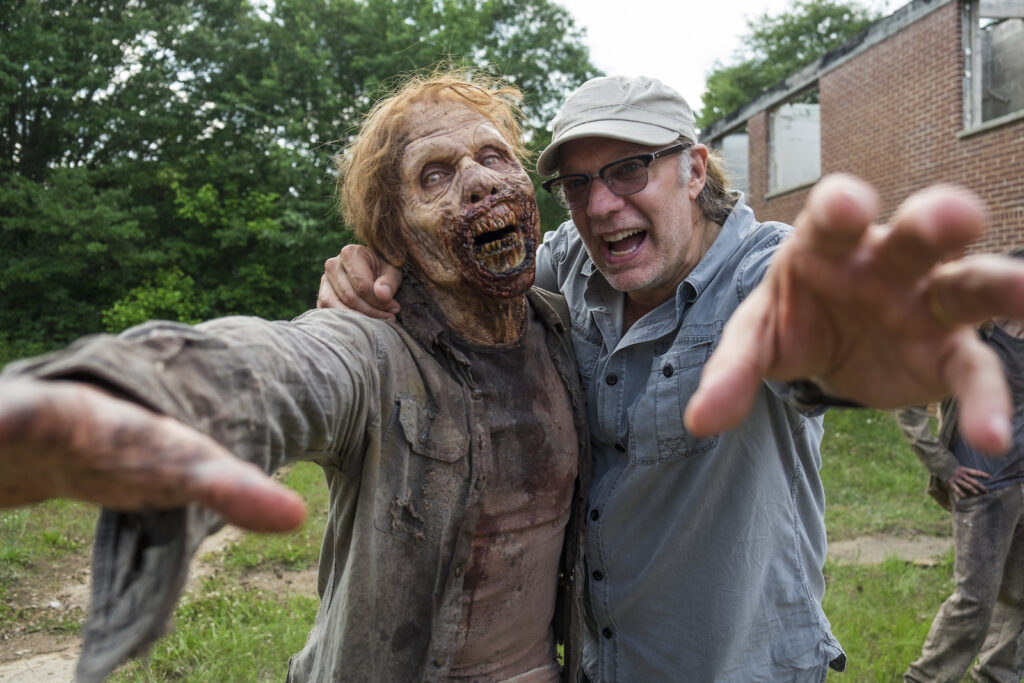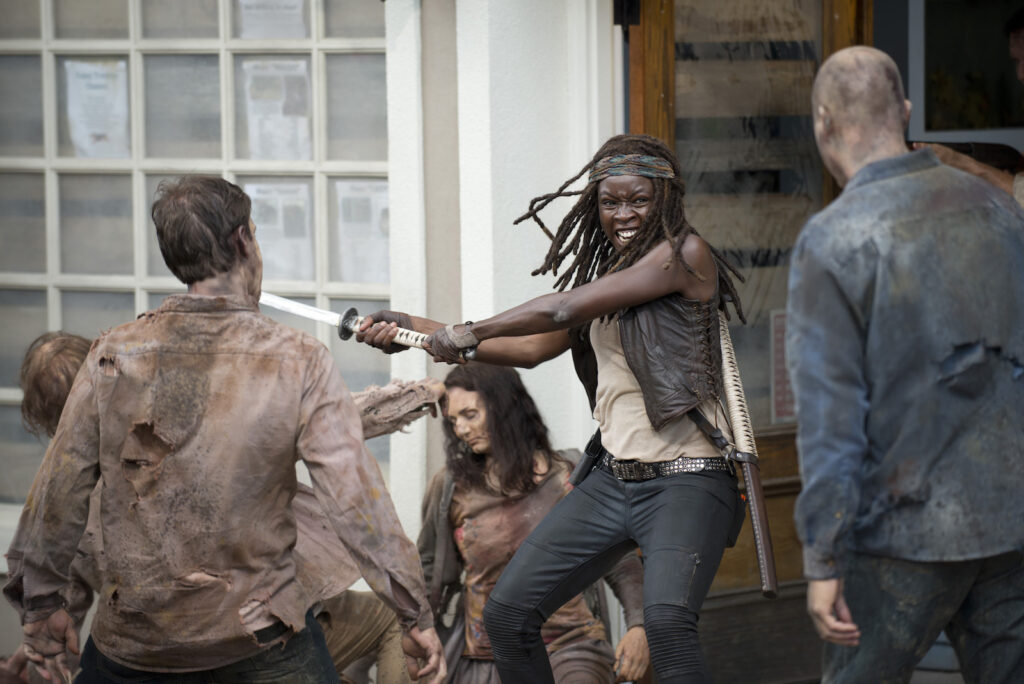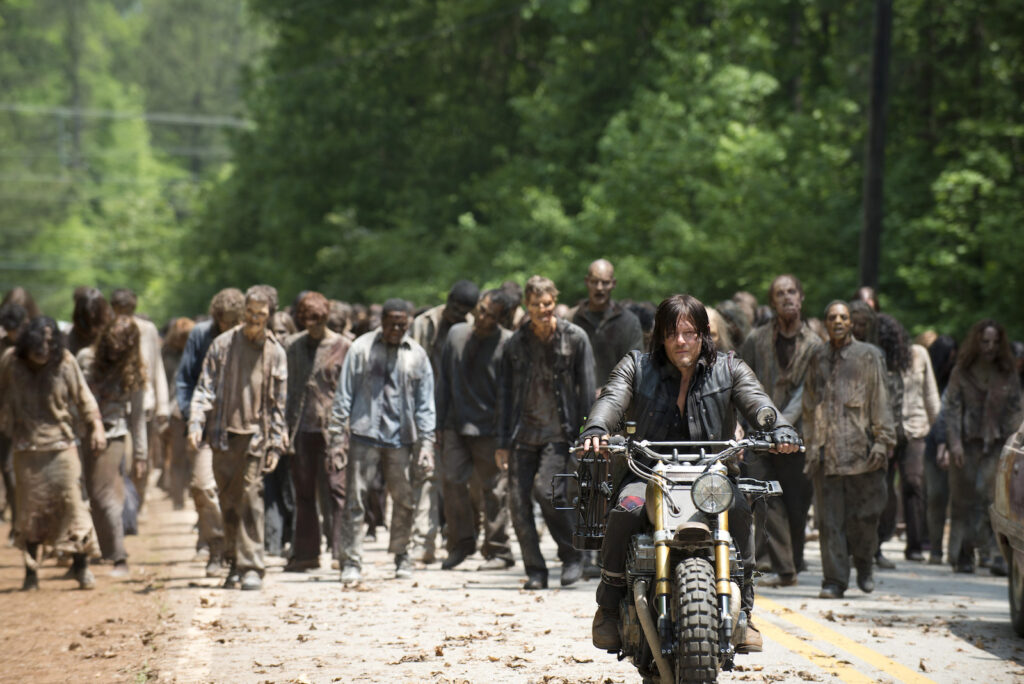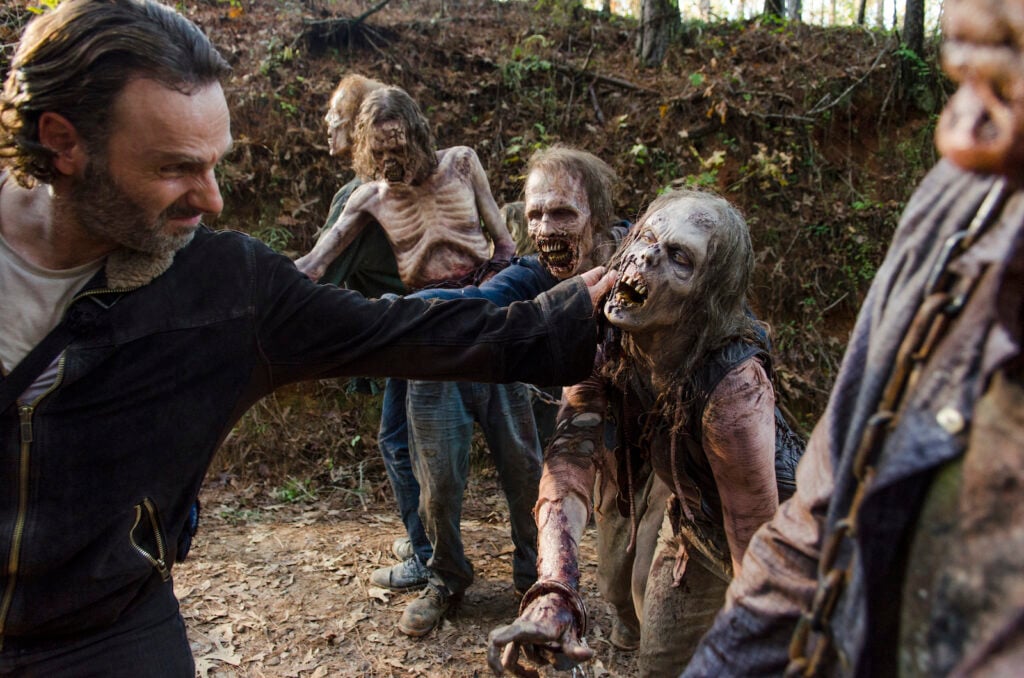Life with The Walking Dead
By Bethan Jones
The Walking Dead asks us how we could retain our humanity in a world overrun by the dead, what hope we could keep alive while struggling to survive against all odds, and what ultimately, is our reason for living. Over the course of 11 seasons—and multiple spin-off texts—The Walking Dead forces us to deal with both the philosophical and the practical questions of living through an apocalypse. Although zombies have featured in popular culture since the 1930s, the zombie originating in Haitian vodou culture as a human whose soul was stolen after death by a sorcerer who has then brought them back to life, it was in 1968 that zombies as we know them entered the public consciousness with George A. Romero’s Night of the Living Dead. The film set the mold for what zombies were: shuffling corpses hungering for human flesh, often a metaphor for mindless consumerism. Although zombies have never really maintained the same popularity as vampires in mainstream media, generations of filmmakers have added to zombie lore, from Danny Boyle’s 28 Days Later, which abandons lumbering zombies in favor of frenzied attacks, to Ruben Fleischer’s comedy horror Zombieland, which became the top-grossing zombie film in history (a record soon broken by World War Z). Yet zombies rarely featured on television. It is perhaps surprising, then, that The Walking Dead premiered on AMC—a network known for prestige TV shows like Mad Men and Breaking Bad—on Halloween 2010.
Zombies had become increasingly popular in other forms of media during the 2000s. Starting with 28 Days Later, the decade also saw three Resident Evil films; the remakes of Dawn of the Dead, Night of the Living Dead, and Day of the Dead; the comedy Shaun of the Dead; and Romero’s Land of the Dead, Diary of the Dead, and Survival of the Dead. Popular video games like Call of Duty featured zombies, and scores of books, including World War Z, The Zombie Survival Guide, and Pride and Prejudice and Zombies, hit the shelves—as did, of course, the comic book series The Walking Dead. Scores of academics and critics have asked what led to the resurgence in the popularity of zombies in popular culture. Some pointed to the effect of 9/11 on the American consciousness. Kyle William Bishop suggested that society has changed markedly since the attack and “because the aftereffects of war, terrorism, and natural disasters so closely resemble the scenarios depicted by zombie cinema, such images […] have all the more power to shock and terrify.” Others argue that the zombie reflects cultural anxieties about refugees, asylum-seekers, and other migrants attempting to enter western states, or that zombie films critique consumer capitalism. The Walking Dead does all this and more, which is perhaps one reason for its runaway success. But it also owes debts to the films that came before it, the changing nature of television production, and, of course, its legions of fans.
Bringing cinema back from the dead?
The Walking Dead TV series took some time to come to the screen. This is, in part, due to Robert Kirkman’s ability to vet all interested parties. He felt that “[t]aking a zombie story that never ends and turning it into a two-hour movie seemed to miss the point,” and it wasn’t until Frank Darabont, a producer, director, and screenwriter known for his film adaptations of Stephen King’s The Shawshank Redemption (1994) and The Green Mile (1999), contacted Kirkman that a deal was struck. Although Darabont may not have seemed a likely suspect for producing a zombie series, he is a professed horror fan, having first watched Romero’s Night of the Living Dead at a midnight screening in 1974. He was also a screenwriter for various horror films including A Nightmare on Elm Street 3: Dream Warriors (1987), The Blob (1988), and The Fly II (1989), and wrote and directed the character-driven science-fiction horror film The Mist (2007). Yet it still took another five years for The Walking Dead to be picked up by a network. The Walking Dead isn’t just horror—it’s hard-edged horror, highlighting the visceral, grisly, and violent forms of the genre and has posed a problem for networks which had often diluted horror shows by including elements from other genres. The Walking Dead, tied closely to the comic, was very steadfastly out-and-out horror and its novelty worked against it.
The eventual greenlighting of The Walking Dead owes a lot to what TV scholars call TV III, or post-digital television. Unlike the early days of TV, when viewers were restricted to a limited number of channels, post-digital television allows audience to choose from a range of subscription channels. Subscription channels like HBO aren’t bound by FCC regulations and target niche audiences interested in “quality” television. As academic Simon Brown has noted, HBO “push[ed] the boundaries of what was acceptable on television in terms of sex, violence, language, and subject matter.” HBO’s success also allowed for the creation of other subscription channels, including AMC. Originally launched as a premium channel offering uninterrupted classic Hollywood films, AMC turned to scripted television in the mid-2000s and used its original programming to complement its existing movie library. So, while shows like Mad Men could play alongside films by Alfred Hitchcock and Breaking Bad could be paired with antihero movies like Dirty Harry, The Walking Dead would augment AMC’s library of horror films. AMC already attracted a core of horror fans thanks to its Monsterfest horror marathon, followed by the gorier yet more popular Fearfest. By this point Gale Ann Hurd had been recruited to the series along with Darabont as executive producer. Another long-time zombie fan whose fandom goes back to Night of the Living Dead, Hurd was also a successful Hollywood producer having produced a number of box-office films including The Terminator and Aliens. Hurd suggested approaching AMC, who were instantly interested, in part because of the movie talent attached to the series.
In addition to Darabont and Hurd, Greg Nicotero was also onboard. A horror afficionado raised on a diet of Jaws, The Exorcist, and Dawn of the Dead, Nicotero entered the industry working under Tom Savini and helped on films by Romero before co-founding special effects makeup company KNB EFX Group, which had worked on Kill Bill, Sin City, and From Dusk Till Dawn. This experience on creating zombie makeup allowed Nicotero to push the envelope on The Walking Dead, creating a range of effects from decomposing zombies entwined in the roots of a tree to close-ups of brains being splattered from a gunshot wound to the head. Even Darabont was surprised at the license they were allowed, saying in the documentary The Making of “The Walking Dead”: “There’s some gruesome stuff in this. I’ve been surprised by what they’re letting us get away with. Even with the freedom that we were promised on AMC there are moment when I go, ‘Really? They’re going to let us do that?’ It hasn’t happened yet.”
Although Darabont was fired weeks into production on the second season of the show and replaced by Glen Mazzara, a controversial move among both cast members and fans, the inclusion of so many Hollywood veterans during Season One lent a sense of the cinematic to the series. While most TV shows are shot digitally now, a conscious choice was made to shoot on 16mm and 35mm film. (16mm was used until the COVID-19 pandemic meant the show had to switch to digital for the safety of cast and crew.) Director of photography Stephen Campbell, who passed away in 2021, explained that 16mm added a classic horror vibe to the show because of the additional grain in the film. Nicotero adds that when they looked at a zombie in the digital test the colors were too green, but when they looked at the 16mm “it seemed to capture what we were shooting for, which was the feel of Night of the Living Dead. It was a no-brainer.” Susan Goldberg, AMC’s director of production, also favored the 16mm explaining, “We have a high standard at AMC for what our shows look and feel like. We feel there is a certain elegance with film, and we think film adds a cinematic quality that fits with the rest of our programming. Feature films air before and after our original series, and we want smooth, elegant transitions.”
As well as shooting on 16mm, the crew worked with relatively lightweight cameras which allow camera operators to run around following the action, but movie conventions are also used in the tone and pace of filming, as director of photography Michael Satrazemis notes when talking about the Season Five finale, “Conquer.” In the episode, Sasha—a main character introduced during the prison arc in Season Three—lies down in a grave full of walkers; discussions between Satrazemis and Nicotero led to the scene being shot using a telescopic camera crane, which meant the camera could focus on Sasha in close-up as she lies down and pull away to reveal more of the scene. Satrazemis says, “That shot was very beautiful and there was no reason to cut to anything else, it could sit there. It became more and more powerful the higher the crane rose and pulled away from it. That speaks to the show’s overall aesthetic, which steers away from the sort of fast cuts and frantic handheld camerawork fashionable in the horror genre in favor of a more classic approach.” Of course, while the look of The Walking Dead lends it a tone in line with classic zombie films, it takes more than that to produce a successful series. The Walking Dead, at its heart, is about the characters.
“A soap opera with zombies and shit”
Think of The Walking Dead and the first character who might spring to mind is Rick Grimes. Certainly, he’s the one we’re most asked to identify with in the early seasons—the reluctant hero searching for his family and trying to keep a small band of unlikely survivors together. In fact, the promotional posters for the first five seasons repeatedly feature Rick on his own. Yet the show features an ensemble cast with backstories and intertwining character arcs that span the seasons, elevating the show to the “quality TV” that epitomized AMC’s “story matters here” tagline. The increase from six episodes after the success of Season One allowed for a serialized narrative that followed specific storylines over the course of each season while still allowing for individual episodes to stand on their own. This means that the audience has to watch every episode in order to understand what’s going on across the entire series. By the time the series aired, 90 issues of the comic had been published, providing the writers and producers with a narrative core that offered an “endlessly deferred narrative”; in other words, while characters might come and go, the central theme—how humans survive an apocalypse—continues. The expansion of a 26-page issue into a 40-minute television episode also meant that more time could be spent exploring characters, themes, and moments.
One of the things The Walking Dead does extremely well in developing its serialized drama is bringing other genres into the mix. The show is a work of horror, but as academic Stella M. Gaynor argues, it layers multiple genres to allow the zombie text to evolve. Season Two, Gaynor writes, “layers the zombie text with the melodrama and extensively borrows from the American soap opera to drive the season”; Season Three draws on the western and its “this town ain’t big enough for the both of us” theme in pitting Rick against the Governor of nearby Woodbury; Season Four gives us a postapocalyptic version of the road movie as our survivors, now fragmented into smaller groups, discover something about themselves. The lack of plot conclusion and the serialized nature of the narrative means that some have referred to the series as a soap opera with zombies—indeed Romero, who was asked to direct a couple of episodes, refused saying, “Basically it’s just a soap opera with a zombie occasionally. I always used the zombie as a character for satire or a political criticism, and I find that missing in what’s happening now.” But the success of the show lies in its characters—these are people we connect with, and the fact that we see them grow from season to season means we also experience the ups and downs of surviving in a postapocalyptic world. As Hurd says, “What's so wonderful about The Walking Dead is that we're able to explore human nature in its most depraved as well as its most humanitarian in each episode. We strip each character down to their most basic survival instincts. You know what zombies are after. What you can't anticipate is how one surviving human is going to interact with another. And that's what keeps the series fresh and compelling.”
Although the zombie apocalypse is the prime focus of Season One, over the years that follow zombies become increasingly part of the background while the human stories come to the forefront. But this hasn’t always been received well. Season Three introduces us to a raft of new characters with the introduction of Woodbury. Reminiscent of the world before the apocalypse, the town has power and food, a trained doctor, and fortified walls. Yet we soon learn that the Governor is a ruthless authoritarian who maintains the safety of the community by killing anyone he sees as a threat. This puts him at odds with Rick, now occupying a former prison not far from the town, and the tension builds over Seasons Three and Four as skirmishes occur between characters from both groups. While I really enjoyed the prison arc, critics generally rank the second half of Season Four more poorly than the first. The scattering of the group of survivors after the governor’s attack led to too many individual threads that could have been handled better and, according to Screen Rant’s Dan Peeke, “marks the start of the show’s demise.” Season Five introduces us to another community, and yet more characters, as Rick’s group discovers Alexandria and a place to settle down. Seasons Six through Eight give us the Saviors, declining viewing figures and possibly the most controversial Walking Dead villain: Negan.
Personally, the most controversial decision made during those two seasons was Glenn’s fake death in the third episode of Season Six. Up to this point, The Walking Dead hadn’t shied away from killing its main characters. Fan favorites like Herschel and characters fans loved to hate, like Lori, had died—sometimes horrifically—on-screen, and when we see Glenn falling off a dumpster into a herd of walkers and apparently being ripped to pieces it is a heart-stopping moment. The episode led to much speculation about whether Glenn was dead or alive, fueled by AMC’s decision to remove Steve Yeun’s name from the opening credits of the next few episodes, but when it was revealed in episode seven that Glenn had crawled underneath the dumpster and evaded the walkers I felt cheated. As a fan I invest in these characters, and it felt like the show was playing with that investment and toying with my feelings. Spending the next few episodes grieving Glenn, only for him to pop up alive, felt manipulative and also removed some of the credibility the show had when it comes to killing off its characters and making some of the stars untouchable. More controversy surrounded Glenn in the Season Six finale. Rick’s group is faced with Negan, the leader of the Saviors with whom they have been locked in combat for half of the season. As punishment, Negan kills a member of the group—the episode ending from the victim's point-of-view, blood dripping down the screen. The Season Seven opener reveals that both Abraham and Glenn were killed, resulting in scores of complaints and a steady decrease in viewing figures. The Parents Television Council, a conservative watchdog, criticized the show for crossing the line in terms of violence and resorting to “graphic violence as a crutch for what used to be better storytelling.” Data from Broadband Choices suggests that some fans at least felt the same way, with viewing figures decreasing throughout Seasons Seven and Eight, before rising slightly in Season Nine.
Fan ratings have increased after Season Eight, with the introduction of Angela Kang as showrunner and a reinvigorated approach to storytelling. And as Season Eleven comes to an end, we can see the growth in all the characters. Carol is no longer a domestic abuse victim; rather she’s a strong woman capable of holding her own and thriving, not just surviving. Daryl isn’t the impulsive redneck we see in Season One but a leader, protector, and trusted right-hand man. Even Negan, despite his assertion in Season Eleven’s seventh episode that “If I got the chance to do it again, I'd kill you all,” is a world away from the brutal leader we meet in Season Six, now working with Maggie to secure food for the community. Far from being a soap opera with zombies, The Walking Dead has given us characters who contemplate the philosophical, political, and cultural meanings of life, characters we can identify with and who stay with us long after their story arc has ended.
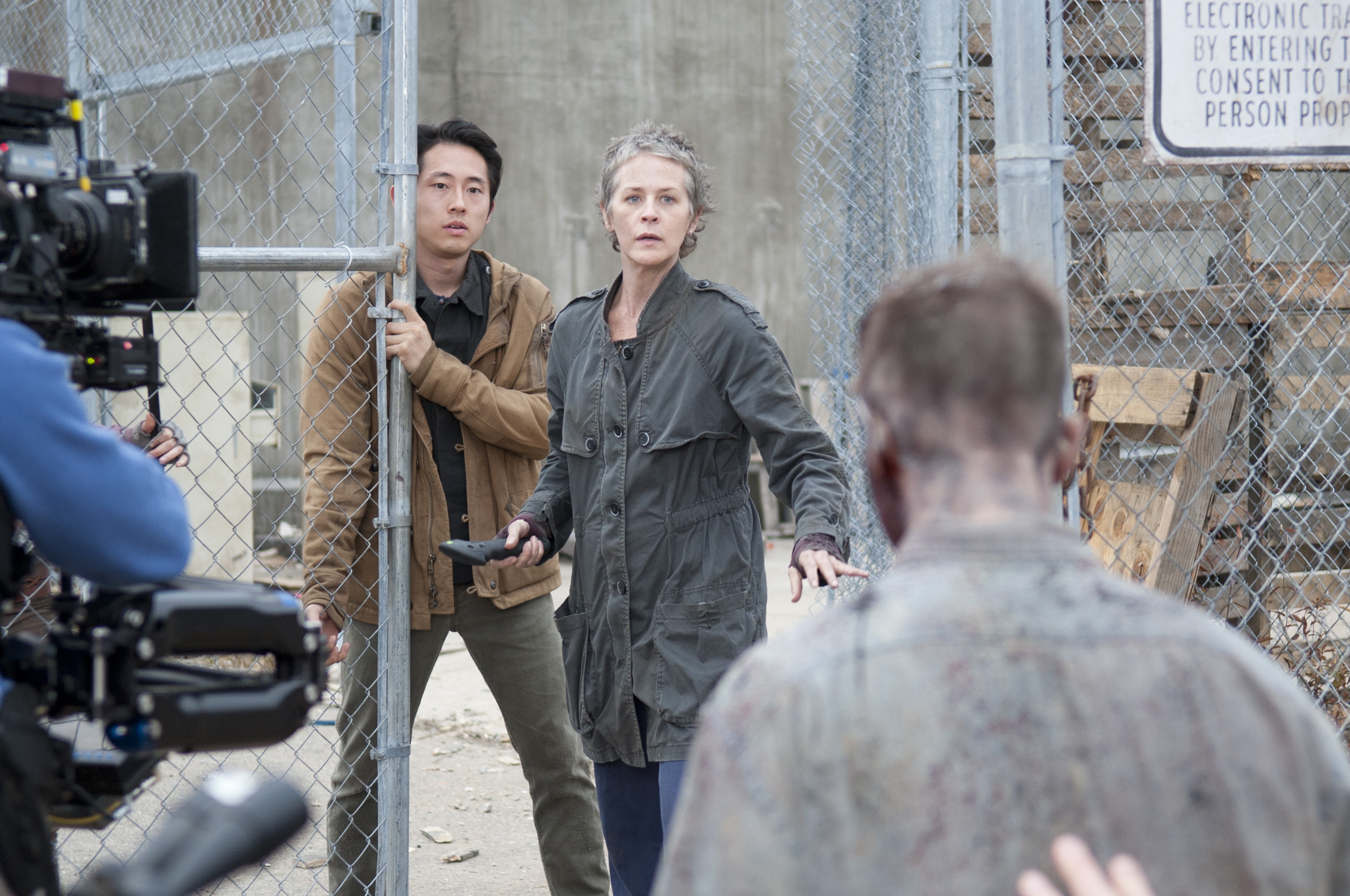
We are The Walking Dead
The 2010 Halloween pilot received 5.3 million viewers, making it the most-watched series premiere of any AMC show. The Walking Dead already had scores of fans from the comic books, and AMC tapped into this fanbase in the marketing of the show. A motion comic based on the first issue was released on the AMC website along with a 30-minute “making of” documentary about the pilot episode. A panel featuring key cast and crew also took place in July 2010 at San Diego Comic Con, where the standing-room-only audience was also treated to an exclusive advance screening of episode one. Comic book fans played a role in promoting the TV series and contributed to the impressive viewing figures for the premiere. The first season averaged 5.24 million viewers, with 2.7 million of those falling within the target 18-49 demographic, and AMC immediately ordered a second season of 13 episodes, set to air in October 2011.
AMC was savvy in marketing the show, using Twitter and other social media sites to connect fans and develop an online community. Megan McCook argued that AMC revolutionized social television, using a range of innovative hashtags on social media, retweeting posts made by fans and encouraging cast and crew to share their thoughts online. This kind of support from networks means fans felt seen and recognized by networks and producers as key drivers for the story to continue. The opportunity to interact with the cast also features heavily in fans’ social media use—it’s not often you find a show’s actors so frequently engaging with their fans. This impression of closeness, of easy access to cast and crew, fed into the idea of the “Walking Dead family,” which began circulating early on in the show’s production. Opening the documentary Inside “The Walking Dead,” Andrew Lincoln refers to the sense of family that has developed amongst cast and crew, a sentiment Hurd echoes, saying, “One of the things that we all feel on The Walking Dead is that we’re part of a big family. And on Twitter we call it the TWD family.” Costume designer Eulyn C. Womble agrees, adding, “The Walking Dead family is a real thing, it’s not just a hashtag.”
Fans are part of that family, not only because they are the dedicated viewers the producers want to attract but also because the participatory nature of the fandom is encouraged by AMC. The first episode of Season Two was immediately followed by a half hour episode of The Talking Dead, a talk show hosted by Nerdist founder and Chris Hardwick. The show features members of the cast or creative team and celebrity “superfans” who discuss the episode that has just aired. Fans submit questions to be read out through social media, and live polls, behind the scenes content, and trivia about the show also form part of the conversation. The Talking Dead features the same kind of fan practices and behavior that take place outside a TV set. Just as Hardwick and his guests analyze particular scenes, so do fans on forums like Television Without Pity and Reddit. The subreddit dedicated to The Walking Dead has over 1.5 million members, and threads discussing everything from favorite villains to continuity errors and fan art regularly feature. In fact, when Beth Greene died in the Season Five mid-season finale, one group of fans took to Tumblr to express their displeasure and created a community around the theory that Beth had survived and would return to the series. She didn’t, but this demonstrates the strength of feeling The Walking Dead fans have towards the show and the many ways that is expressed. Of course, this expression of feeling works both ways, with the amount of violence in the latter part of Season Seven toned down apparently because of complaints from fans about the season premiere.
Another thing that sets The Walking Dead fandom apart from other franchises is where it’s filmed. While Walking Dead fans are found across the globe (the show is huge in Japan), it also holds a special place in Atlanta, having filmed extensively around the city since Season One. Atlanta Movie Tours, for example, was created by fans of the show in 2012 and ran Walking Dead tours until closing in 2020, featuring extras from the show as tour guides. Visitors are able to see key locations from episodes, hear stories from behind the scenes, and occasionally meet stars like Cooper Andrews, who plays Jerry in the later seasons. A quote from Greg Nicotero on the wall of the Atlanta Movie Tours shop highlights the sense of community evident in both the official and fan discussions about the show: “That’s the thing about The Walking Dead that amazes me, because it’s literally become a communal experience. People get together and experience it together. And that’s a tremendously rare phenomenon.” Many fans also attend events dressed up as walkers or their favorite character (Negan, Rick, and Daryl are all common sights). Cast members, including Norman Reedus, Jeffrey Dean Morgan, Sonequa Martin, and Ross Marquand are familiar faces at conventions and take the time to meet thousands of fans: at one convention Reedus bought pizzas for those who had stayed waiting for his autograph hours after the convention officially ended. The relationship between cast and fans is just one reason for the passionate fandom the show generates—a reason why that fandom will continue long after the show ends.
It’s their world. We’re just living in it.
In this essay I’ve talked about The Walking Dead as a phenomenon and the different factors that have contributed to its success—I’m an academic; it’s what I do. But I’m also a fan of the show and have been since the first episode aired in the U.K. When I first started watching I had to record the episodes onto my DVR and watch them while eating tea the following day. Partly so that I could watch them during daylight hours and partly so that I had something to distract myself from what was on-screen. Fast-forward twelve years and I now watch with the lights turned off and no distractions. While horror films scare the living daylights out of me, and The Walking Dead is fundamentally horrific, the gore doesn’t bother me anymore. I can certainly appreciate the technical expertise of Nicotero and his team, but for me the characters are the heart of the series and the reason, I think, why the show has connected with so many.
While we might not be living in a zombie apocalypse, the struggles we see Rick and his fellow survivors deal with strike at the heart of what it means to be human. When we first meet Carol Peletier in Season One, she is a scared victim of domestic abuse, yet, following the death of her daughter—an event that would break many—she finds inner strength and becomes a vital member of the group, willing to take on and kill anyone she considers a danger. Carol becomes harder as her storyline develops, but another main character becomes softer. The younger brother of a racist redneck, Daryl Dixon is aggressive and surly when we meet him in Season One. Yet he develops a close bond with Carol and eventually becomes a leader in his own right. The beauty of a TV series rather than a film is that it allows the audience to become invested in the characters over a much longer period of time and allows for a deeper exploration of the philosophical questions about what it takes to be human and what it means to survive. The Walking Dead might have drawn on the years of zombie lore that preceded it, but it has become something much more: a community spanning geography, race, and class, united by a show that focuses more on the living than the dead.
Bethan Jones is an academic and a geek. She works in media and cultures studies, her PhD research focusing on anti-fandom, hatred, and toxicity online, and she has written extensively about fandom, media tourism and participatory cultures. Bethan has co-edited several books and journal special issues and is currently writing a book about The X-Files ahead of its 30th anniversary.
Bibliography
AMC. 2010. ‘The Making of The Walking Dead.’
AMC. 2014. ‘Inside The Walking Dead.’
Barton, Steve. 2010. “Executive Producer Gale Ann Hurd talks The Walking Dead.” Dread Central. 30 July.
Berkshire, Geoff. 2015. “‘Walking Dead’ Cinematographer on the Taxing Season 5 Finale” Yahoo!News. 3 June.
Bishop, Kyle William. 2010. American Zombie Gothic: The Rise and Fall (And Rise) of the Walking Dead in Popular Culture. McFarland & Co.
Brennan, Matt. 2020. “Cable TV can survive the streaming wars. AMC chief Sarah Barnett explains how.” LA Times. 16 January.
broadbandchoices. No date. “Jumping the Shark.” broadbandchoices.
Brown, Lane. 2010. “Nights of the Living Dead”. New York Magazine. 21 October.
Brown, Lane. 2010. “The Walking Dead Creator Frank Darabont on the Zombie Show Too Gruesome for Major Networks”. Vulture. 29 October.
Brown, Simon. 2010. “Cult Channels: Showtime, FX, and Cult TV” In Stacey Abbott (ed). The Cult TV Book. I.B. Tauris.
Fehrle, Johannes. 2016. "’Zombies don't recognize borders’: capitalism, ecology, and mobility in the zombie outbreak narrative.” Amerikastudien/American Studies, pp.527-544.
Gaynor, Stella M. 2022. Rethinking Horror in the New Economies of Television. Springer Nature.
Goldberg, Leslie. 2016. “Parents Television Council Blasts “Brutally Explicit” ‘Walking Dead’ Premiere (Exclusive)”. The Hollywood Reporter. 24 October.
Heurig, David. 201. “A Cinematographer Among The Walking Dead.” Studio Daily. 3 November.
Jowett, Lorna and Stacey Abbott. 2013. TV Horror: Investigating the Darker Side of the Small Screen. I.B. Tauris.
McCook, Megan. 2013. “The Walking Dead Revolutionizes Social Television.” Social Media Today. 2 March.
MacKenzie, Steven. 2013. “George A Romero: ‘The Walking Dead is a soap opera with occasional zombies’”. Big Issue. 3 November.
Peeke, Dan. 2022. “Every Season Of The Walking Dead, Ranked By IMDb Average”. ScreenRant. 14 April.
Rafferty, Terrence. 2015 “On the Air – The Walking Dead”. Directors Guild of America.
Stratton, Jon. 2011. “Zombie trouble: Zombie texts, bare life and displaced people”. European Journal of Cultural Studies, 14(3), pp.265-281.

